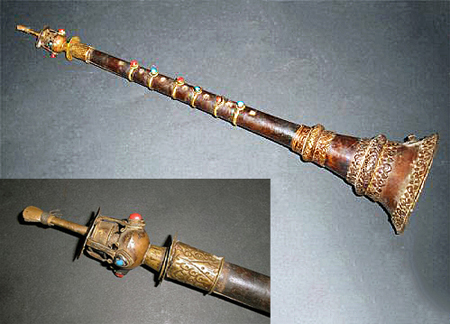
Owner: HWMC
Catalogue #: AS-AERV-07
Reedpipes
Nepal ‘Ghyaling’
Nepal
Tamang and Sherpa People
Wood, metal, reed. coral
Late 19th century
Height: 18 in
Aerophones – Wind Instruments Proper – Reedpipes
The ghyaling (rgya-gling) is a Nepalese reed instrument (oboe). Double reed instruments, sometimes referred to as ‘trumpets,’ are also common in the Middle East where it is known as a zurna in Turkey and Iran. In China it is called the suona (shawm). In Central Asia, it is known as a surnay, and in Mongolia it is called a bishgüür, while in Egypt and North Africa it is referred to as mizmar.
This ghyaling has a hardwood body with seven front finger holes, decorated with brass rings and blue and red coral embellishments. It has a large copper and brass bell at the end. The reed is a stem of marsh grass, folded. The player uses the technique of circular breathing for extended phrases by taking the reed completely into their mouth and pressing their lips against the disk above the pirouette’s bulbous assemblage. The ghyaling is played by the Tamang people, a Tibeto-Burmese ethnic group of Nepal and the Sherpa, a mountain-dwelling people of Nepal. It is used in Buddhist ceremonies and is played as a matched pair with some prayers or scripture. The ghyaling may also be played alongside the radong/dungchen/labha trumpets and bupsel (small brass cymbals).
Reference: Nationaal Museum van Wereldculturen (NMVW) (transl. National Museum of World Cultures), Neitherlands.
